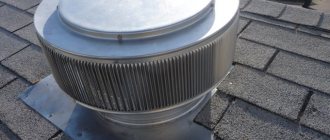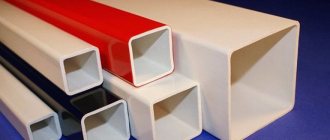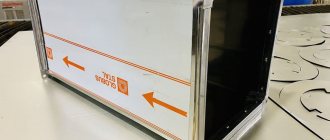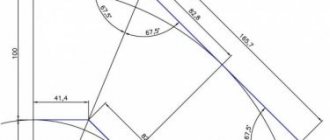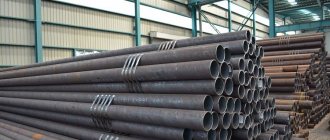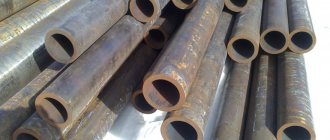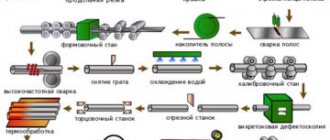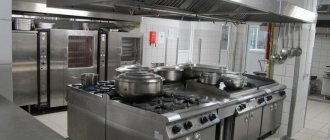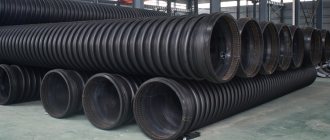2018-08-14
Rather, you need to ask this: how thick should the air duct for ventilation be? Because choosing a box with a smaller thickness can lead to dangerous consequences. However, first things first.
Ventilation ducts are made of sheet steel, and the thickness of the galvanized sheet depends on the size. The greater the length/width or cross-sectional diameter, the thicker the metal should be used.
Advantages and disadvantages of galvanizing
Galvanized air ducts are the most common type of ventilation pipes. This is easily explained by the characteristics of the metal.
Advantages of galvanizing:
- Light weight, due to which the installed structures create insignificant loads on buildings. In addition, the lightness of the material facilitates the process of delivery to the installation site and engineering work.
- The flexibility of the material makes it possible to give the air duct elements any shape, which not only expands their model range, but also improves the aerodynamic characteristics of the line.
- Durability and resistance to open fire and aggressive environments. This significantly expands the scope of use and increases the service life of ventilation pipes made of thin-sheet galvanized steel from 10 years or more.
- Low cost compared to other metal analogues.
Galvanized ventilation ducts are easy to maintain. They do not require preliminary priming, since the metal is not subject to active corrosion. The aesthetic appeal allows them not to be painted.
The disadvantages of galvanized steel include:
- Increased noise level, typical of any metal structure. However, this problem can be solved either by a well-thought-out wiring diagram that minimizes the number of bends and transitions, or by sound insulation.
- Tendency to form and accumulate condensation. The solution is to insulate the pipeline.
- Susceptibility to deformation as a result of powerful mechanical stress caused by a strong impact, displacement or fall of the structure. Under normal operating conditions, such difficulties do not arise.
The combination of quality, cost of material and a variety of technologies to minimize disadvantages makes galvanized pipelines the most popular types of air ducts used in the construction of ventilation mains.
Marking
In SNiPs, on the basis of which ventilation and air conditioning systems are built, there are no strict requirements for the marking of air ducts. That is why builders do not carry it out. But many contracting organizations are silent or do not know that GOST 14202 clearly states that air ducts must be marked. If air is transported through them, then they should be painted blue on the outside. The appendix of this GOST indicates exactly what shade the blue paint should be.
In Europe and America, marking is mandatory. In Russia, at some facilities, installation organizations also carry out painting of air ducts if these facilities are constructed according to international standards.
Types of galvanized air ducts
The variety of galvanized air ducts is due to a number of technical characteristics that are endowed with the products during the production process. So the following types of products are distinguished:
- Cross-sectional shape: rectangular or round.
- By type of seam: welded and seamed.
- In the direction of the seam: spiral-wound and straight-seam.
Rectangular and round
| Round steel duct | Rectangular steel air duct | |
| Aerodynamics | Uniform air distribution and, as a result, improved aerodynamics. | High aerodynamic drag |
| Air mass movement speed | High. | Low. For large circuit sizes, forced air circulation is required. |
| Noise figure | Good noise-absorbing properties due to the absence of turbulence effect. | High-quality sound insulation is required. |
| Care requirements | High air speed prevents dirt and dust particles from settling in the pipeline. | Requires periodic cleaning of the pipeline. |
| Calculation data | The cross-sectional shape makes it difficult to calculate data on the area of the structure. | The rectangular configuration makes calculations easier. |
| Installation | The products are lighter and do not require reinforced fastenings. Time saving and low labor costs. | The weight of the structure requires the installation of reliable fasteners. |
| Price | Cheaper by an average of 30%. Minimum costs for transportation, storage, installation and thermal insulation. | Due to its high aesthetics, there are no costs for masking and decorating the highway. |
The advantage of rectangular air ducts lies in the configuration and diversity of the model range, which allows you to adapt the ventilation circuit to the characteristics of any room without compromising the calculated cross-sectional area, playing with the width and height of the pipe.
Straight seam and spiral wound
Straight seam ones are made by bending a sheet of galvanized steel into a round or rectangular pipe. This technology makes the product cheaper, but it also limits its length, which increases the number of pipeline connecting elements.
Spiral-wound (spiral-lock or spiral-welded) air ducts are twisted from a thin metal strip. In this case, the seam runs in a spiral and plays the role of a stiffener, which increases the strength of the pipe, and when using the welding method, ensures its tightness.
Spiral-wound air ducts are characterized by:
- less weight;
- increased tightness;
- a small number of joint elements;
- increased speed of movement of the air mass, because the spiral shape creates additional rotation in a closed loop;
- reduced noise level.
However, the ribbing of the surface provokes the accumulation of dust inside the pipeline.
Tightness and density
Tightness and pressure are indicators that ultimately determine the efficiency and cost of the ventilation circuit. A leaky pipeline reduces the quality of air exchange and entails an unreasonable increase in the power of pumping equipment, an increase in energy costs, and also leads to the accumulation of condensate inside the pipes.
There are 3 classes of air duct tightness:
- A (low). Air permeability from 1.35 to 0.45 l/sec/m².
- B (medium). Air permeability from 0.45 to 0.15 l/sec/m².
- C (high). Air permeability less than 0.15 l/sec/m².
According to the coefficient of internal pressure (density) there are:
- N-models (normal pressure). Designed for ventilation and smoke removal systems for objects classified as fire hazard classes “B” and “D”. They do not require strong sealing, because allow a certain percentage of leakage. Rubber seals are usually used as a sealant.
- P-models (dense). Installed at facilities equipped with powerful pumping equipment and classified as fire and explosion hazardous. They are characterized by 100% tightness of seam joints and the presence of an airtight lock at the junction of elements with each other.
Design Features
Today, there is a wide variety of designs for this equipment, including standard categories and non-standard ones. In non-standard type structures, both mesh and stiffening ribs can be additionally used, as well as various fastening elements along with reinforced flanges. Galvanized air ducts for smoke removal systems in Moscow are manufactured in the following sections: • Rectangular. Due to the specific shape, they are convenient to install in various buildings. The pipes are connected to each other using flanges. However, there are designs that do not require the use of flanges. Rectangular air ducts have a wide range of applications, ranging from educational institutions and residential buildings to industrial premises. • Round. They are distinguished by a more uniform distribution of air masses and an affordable cost. This type of equipment is characterized by high noise-absorbing properties, greater tightness of joints and lower weight. It is worth noting the ease of installation. Round air ducts are divided into spiral-lock and straight-seam.
Which is better and where is it used?
The protective layer of zinc resists the destructive effects of open air, moisture and ultraviolet radiation. Therefore, galvanized ventilation ducts are actively used both indoors and outdoors for arranging systems:
- natural and forced ventilation,
- air conditioning;
- aspiration (removal of small particles contained in the air);
- smoke removal (removal of combustion products);
- exhaust gas removal;
- transportation of gas mixtures, air purifiers and humidifiers.
Even the organization of a regular hood in the kitchen is most often done through steel air ducts.
When deciding on the use of one or another type of air ducts, one should be guided by the operational features of the future design:
- Rectangular air ducts are used to save space in small, predominantly residential or office premises (private houses, apartments or offices).
- For aspiration and transportation of harmful gases, round pipes with a welded seam are suitable, ensuring maximum air movement speed and complete sealing of the housing.
- In industry, preference is given to round shapes, which are characterized by both the greatest efficiency and minimum cost.
Materials
The variety of materials for the manufacture of air ducts is due to differences in operating conditions in a particular room.
- Galvanized air ducts. Their use is permissible in a non-aggressive environment with a temperate climate (up to +80 degrees). Not being exposed to moisture will prevent mold from appearing on the walls of the air duct made of this material.
- Air ducts made of stainless steel. They ensure the movement of air flows at the highest possible temperatures, reaching +500 degrees Celsius. Fine-fiber heat-resistant steel is used in their manufacture.
- Plastic air ducts. They are used in both domestic and industrial environments. The main material is polyvinyl chloride, which is not susceptible to moisture. This material is extremely light and smooth, which ensures excellent air movement in the channels. Complete tightness allows the production of all kinds of connecting elements from plastic for fastening several air ducts.
- Foil ducts. Refers to flexible air ducts. Their production uses a steel frame, transparent polyester and multi-layer foil. This product is famous for its reliability and serves for a long time without loss of characteristics. All materials for the manufacture of such air ducts do not contain harmful substances. The connection of foil sheets is ensured by the use of acrylic glue.
Elements of the ventilation system
A ventilation duct is always a complex structure, consisting of numerous elements that allow:
- change the direction of the contour depending on the configuration of the premises;
- go around ledges;
- connect several circuits into a single network.
Bends and boxes
The main elements of the air duct that determine its direction are ducts and bends. The former pave the path in a straight line, the latter change the contour geometry at an angle of 15⁰, 30⁰, 45⁰, 60⁰ or 90⁰.
Other shaped elements
Ventilation is a complex and extensive network of channels, which is problematic to install without the appropriate elements. Such components are usually called shaped products.
These include:
- Adapters connecting circuits of different diameters to each other - confusers and diffusers. The former narrow the highway, the latter widen it.
- Tees and collar inserts that ensure the adjacency of two highways to each other.
- Crosses used to intersect two perpendicular air flows.
- S-shaped adapters (canards) connecting two contours that do not coincide in axis and/or cross-section.
- Round nipples and couplings connecting two round boxes. The first ones are inserted inside, the second ones are put on top of the pipes.
- Plugs installed at the ends of the circuit.
- A roof umbrella that prevents precipitation from entering the ventilation shaft.
- Supply and exhaust grilles and other fittings.
Stages of fire protection work
All work on thermal protection of air ducts of the smoke exhaust system can be divided into several stages:
- Development of a project with a complete list of activities.
- Coordination of design documentation with fire authorities.
- Obtaining an expert opinion on the work.
- Fire protection of air channels.
After completing the work, the contractor company must issue a certificate to the customer, with signatures of representatives of fire supervision, confirming compliance with regulatory documents and technical specifications.
For another way to protect air ducts, watch the video:
Dimensions
GOST
- GOST 14918-80 - air ducts made from steel sheets with a thickness of 0.5 to 1 mm by rolling and intended for transporting air with a humidity of no more than 60% and a temperature of less than 80⁰C.
- GOST 5632-72 - air ducts characterized by a high degree of tightness, resistance to corrosion and high temperatures (about 500⁰C) and designed to move hot air and chemical gases.
Weights and Diameters Size Chart
Why is thin steel used and why shouldn’t it be done?
For air ducts of various sizes, some unscrupulous manufacturers use steel thinner than necessary. As a result, the walls are “underestimated” in their thickness by up to 1-2 mm. This is done for a banal reason – dumping. So if the cost of the air duct is unreasonably low, then there is a possibility that thinner steel was used than required by SNiPs.
Installing air ducts made of thin metal is already considered a violation. This is a threat to the lives of people inside the building. “Thin” ventilation will either quickly fail or simply work extremely ineffectively. The reason is simple - air flows moving inside the box place a high load on the thin walls, as a result of which the latter fail.
Consequences of using thin steel for air duct:
- Air loss – inefficient operation of the entire system + constant noise and high vibration
- Rapid appearance of corrosion on the surface of the pipeline itself
In a word, repairing air ducts is not only a considerable expense for the repair itself, but also for the downtime of the entire ventilation network. Therefore, you need to carefully select air ducts and shaped elements, not make questionable savings, and check the compliance of the supplied products with the standards.
Production of galvanized air ducts
Galvanized air ducts are manufactured on special metalworking equipment from thin-sheet cold-rolled steel in accordance with the standards established by the state (SNIP 41-01-2003 and TU 4863-001-75263987-2006). Metal cutting occurs automatically according to the parameters specified by the program.
- Parts with a round cross-section are processed by rollers, which set the workpiece to the required diameter, followed by rolling the longitudinal edge on a folding machine.
- Spiral-wound ones are made using a different technology: steel 137 mm wide is twisted in a spiral with the seam inward.
The use of high-quality galvanization does not allow the galvanized coating to peel off from the metal in places where the product is bent.
Technological standards require the use of metal of a certain sheet thickness for each type of section:
| Air duct diameter, mm | Steel thickness, mm |
| 80 — 315 | 0,5 |
| 355 — 800 | 0,7 |
| 900 — 1250 | 0,9 |
| 1400 — 1900 | 1,2 |
Specifications
- Sheet thickness : 1; 1.2; 1.5; 2; 3; 4 mm. Depends on the diameter or length of the side.
- Straight section length: from 100 to 2500 mm, standard – 1250 mm.
- Aspect ratio: from 1:1 to 1:4 (if greater than 1:3, additional stiffeners are made).
- Connection type : flanged, wafer.
- Corner size : 25x25x3, 32x32x3, to order - 50x50x5.
- Coating : anti-corrosion primer GF-021.
- Sealing during assembly : necessary.
- Operating temperature : up to 400°
- Operating environment : chemically aggressive.
- Manufacturing according to individual drawings : yes.
- Regulatory documents : GOST 19903-74 and GOST 16523-70.
Average cost and where to buy
The cost of air ducts made of galvanized steel depends on the size of its cross-section and the thickness of the metal. The price is calculated per 1 m². On average, the market cost of 1 m² of product is about 320 rubles. Installation work will cost an average of 700 rubles. for the same square meter.
Despite the wide presence of air ducts in online stores, it is still worth buying them directly from the manufacturer, who can provide each product with a quality certificate.
Fire resistance limit
Galvanized air ducts must provide certain conditions for maintaining their parameters during fires and non-propagation of fire. For this purpose, there are fire resistance standards that divide all building materials into five classes. So, galvanized air ducts belong to class zero. Therefore, pipes laid under the ceiling must withstand the fire temperature for 90 minutes, and pipes laid along the walls - 30 minutes.
Fire resistance testing of air ducts is carried out at the facilities themselves where the ventilation and air conditioning system is being constructed. In this case, SNiP 2.04.05-91 is used. Methods of protection:
- traditional using foil material;
- applying protective fire-resistant compounds using equipment;
- combined method.
How to choose?
The operation of the air exhaust system (AWS) depends on how correctly its cross-sectional area is calculated.
S=P/v, where
S - Sectional area.
P — SVO performance.
v - The speed of movement of the air mass (for residential premises an indicator of 3-4 m/s is used).
Determining ventilation performance involves determining the amount of air required for a comfortable stay in the room. It is calculated in 2 ways:
- By volume of air required:
P=A × n, where
P — SVO performance.
A - Number of people in the room during an hour.
n — Air consumption rate according to SNIP 41-01-2003 and MGSCh 3.01.01.
- By frequency of ventilation (ventilation):
P=V × k, where
P — SVO performance.
V - Volume of the room (with equal data, the entire room)
k - ventilation rate established by SNIP standards 41-01-2003.
Shape and diameter
The quality of air exchange, energy efficiency and room design depend on the selected configuration and size of the air duct cross-section. Therefore, the choice of air channels should be approached carefully:
- The smaller the diameter of the air duct, the higher the speed of movement of the air mass. It is important to be guided by the principle of the “golden mean”, because the higher the speed, the higher the noise level.
- Round ducts provide faster air movement, are easier to install and are cheaper.
- Rectangular ones are stronger and fit harmoniously into the design of any room.
Construction and rigidity
Depending on the specific application of the design, there are:
- rigid, semi-rigid or flexible;
- standard or thermally insulated;
- fire retardant.
The tighter the seams, the stronger the connection and the longer the service life.
Material
Galvanized ventilation ducts are manufactured in a standard type and insulated.
- The design of insulated models includes a special insulating layer made of mineral fiber, polyurethane, foam elastomer, felt or other materials. They maintain the optimal air temperature inside the circuit, preventing the formation and freezing of condensation on the walls. In addition, the noise level is reduced.
- The zinc coating can be single-sided or double-sided. Due to the formation of condensation inside the circuit, double-sided galvanizing is more practical, because protects the circuit from internal corrosion process.
Not long ago, aluminum-zinc-coated air ducts appeared on the market, the coating of which is 95% zinc and 5% aluminum. They are characterized by greater ductility and improved anti-corrosion properties.
Fastening
Methods for fixing air ducts depend on the configuration:
- with a round cross-section, coupling, bandage and nipple connections of elements are used;
- rectangular air ducts are fastened using latches and mounting angles.
Sometimes welding is used.
Fire protection
The smoke removal system operates under open combustion conditions, when the ambient temperature can be several hundred degrees. Air ducts must ensure uninterrupted removal of smoke from a burning building for at least 2 hours at a gas temperature of 400°C. To protect against melting and burning of air ducts, special fire-resistant mixtures or thermal protective roll materials made on the basis of basalt fiber are used.
Class “H” ducts located in buildings with a low fire hazard level can be painted as fire protection with a special paint that protects the duct for an hour at temperatures of transported gases up to 120°C. Among the painting materials there are special compositions that foam when the air temperature rises to 100 degrees. This achieves an increase in their thermal stability.
Rules for installing galvanized ventilation
The laying of ventilation ducts from thin-sheet galvanized steel takes place in stages.
- The links are assembled into blocks. Sealed.
- Fasteners are installed on the mounting plane.
- The prepared blocks are lifted and fixed in a given position using galvanized punched tape.
- The blocks are connected into a single network.
- If necessary, work is carried out on thermal insulation and decoration of the highway.
The thickness of the punched paper tape is selected depending on the weight of the elements (from 0.55 to 0.7 mm).
Features of installation of air ducts
The performance of the smoke protection system directly depends on the quality of installation of air ducts. Installation of smoke exhaust ducts is carried out using stands, hangers and other fasteners, which are specified in the design documentation.
All fasteners are made of steel. There are no requirements for treating fastening elements with fire-resistant compounds, but it makes sense to cover these products with fire protection, since burning through the air duct fastening will inevitably lead to the collapse of the entire smoke exhaust system.
- Smoke protection air vents with a round cross-section are connected to each other using flanges made from a steel strip, and those with a rectangular cross-section are connected from a tire.
- When installing shafts and channels, all flange connections are sealed with asbestos cord so that when the nuts are tightened, there are no gaps left between the flanges.
- Fastenings of horizontal sections of air ducts are installed at a distance from each other of no more than 6 m. Fastenings of vertical sections of air ducts are made at a distance from each other of no more than 4 m.
After the installation of the smoke exhaust system channels is completed, the equipment is installed and the air ducts are treated with a fire-resistant mixture.
Advice: Air ducts of smoke exhaust systems are the main structures that ensure the safety of life and health of people in the event of a fire, preventing them from suffocating by combustion products. That is why the installation and fire protection of air ducts should only be carried out by professionals who have all the permits for this.
Tightness classes
The modern approach to properly organized ventilation is to ensure complete tightness of the air ducts. The density of this system was mentioned above. And these two classes can also be included in the tightness category. It is they who determine the work carried out in Russian construction organizations, because all this is indicated by SNiP 3.05.01-85.
It clearly states that there are several very important reasons why the tightness of galvanized air ducts is monitored.
- The effectiveness of a ventilation system decreases sharply when the airtightness of ventilation sections and pipes decreases. At the same time, repair and maintenance processes become more complicated. And since sanitary standards clearly stipulate what the air exchange should be in certain rooms, accordingly it is necessary to strictly adhere to the established requirements. This means that leaks have to be minimized.
- The insufficient supply of fresh air and the outflow of used air from the premises creates conditions in which a person is uncomfortable to be. In addition, it is harmful to health. Therefore, it is necessary to increase the power of application equipment. Which entails an increase in energy costs.
- If the tightness of galvanized air ducts is broken, and if the ventilation area is located in an unheated room, then there is a high probability of condensation forming inside the pipes.
Shape of the internal section of the air duct
According to the shape of the internal section of the channel, air ducts differ in:
- round;
- flat oval or oval;
- rectangular.
Round air ducts are rightfully considered the most effective. They have the least air resistance and, therefore, less pressure loss. In addition, round air ducts are cheaper than rectangular and flat-oval products. Rectangular air ducts are less efficient, but due to their compactness, their use is widespread in the construction of buildings. There is also such a point - until recently, equipment for the production of round air ducts cost one or two orders of magnitude more than what was used for the production of rectangular ones. And although the situation has already changed, there are quite a few manufacturers of rectangular air ducts on the market.
Flat-oval air ducts are the least common, but they are superior to both rectangular and round air ducts in certain parameters.
Leonty Pashkov, Leading Manager
“A distinctive feature of textile air ducts is that they are calculated and manufactured for a specific object, for a specific technical specification. “Many factors are taken into account: the dimensions of the room, the height of the air ducts, temperature conditions and, of course, the wishes of the customer.”
The advantage of rectangular air ducts over round ones is that they fit more organically into the interior, they are easier to fit into a corner under the ceiling, but this is where their advantages practically end.
Recently, rectangular ventilation pipes have often been replaced with round ones. The surface area of a round air duct is 12% less than the surface area of a square air duct with a similar open cross-section. When the aspect ratio of a rectangular duct is 1:4, the difference increases to 40%. This makes it effective to replace one flat duct with several round ones running in parallel.
If we compare the efficiency of round and flat oval air ducts, the primacy will remain with traditional round air ducts. But flat oval ducts, in addition to being able to be compactly placed where round ducts take up too much space, are more efficient than rectangular ones. Air pressure losses in flat-oval air ducts are significantly lower due to rounded corners and less turbulence of air flows in the air duct.
In addition, the appearance of flat oval air ducts is superior to both of their “competitors,” which makes them especially valuable when placed openly in a space.
Popular models
Round duct Lissant
Aluminum channel Vents P
Straight section of the round air duct NEMZ "Tayra"
Air ducts: all models
Polymer corrugated air ducts are in many ways similar in quality to aluminum ones, but can be painted in different colors, have an antibacterial coating and are easier to combine with other air ducts of various diameters and profiles.
Plastic air ducts are highly durable; to install them, it is enough to have a standard set of tools (they are cut with a regular hacksaw with a fine tooth, and the edges of the cut elements are not sharp). The main advantages of plastic air ducts for the ventilation system are:
- long service life,
- ease of installation and repair,
- no fasteners are required when assembling the ventilation system,
- good anti-corrosion properties,
- light weight,
- relatively low cost.
The main disadvantage of plastic air ducts is their low level of resistance to high temperatures and mechanical shock loads.
Plastic air ducts for kitchen hoods
Plastic air ducts are very popular today - especially when installing hoods in the kitchen. But adherents of this type should remember that, according to SNiP 41-01-2003, paragraph 7.11, plastic air ducts can be used in low-rise residential, public, administrative and industrial buildings of category D. They cannot be laid in basements, crawl spaces, attics and technical floors, in rooms with standardized fire safety conditions.
Fabric or textile air ducts are made from technical textiles. Such air ducts are installed on the supply part and do not have embedded ventilation grilles at the end of the network: due to the air permeability of the fabric, the air is evenly distributed throughout the entire volume of the room. Textile air ducts have appeared on the Russian climate market relatively recently. But air distribution systems have already proven themselves to be reliable, easy to use and require less energy.
This type of air duct fits organically into the interior; in many cases, ventilation made from textile pipes does not need to be covered with ducts. It is possible to make air ducts from fabric with a decorative pattern. Their other advantages include:
- textile air ducts can be operated in the temperature range from -10ºС to +110ºС;
- they are resistant to moisture and chemicals;
- some models have antibacterial properties;
- they are relatively light in weight and easy to install;
- textile ventilation pipes are characterized by high throughput and uniform air distribution;
- they are easy to repair and clean, the fabric can be cleaned using a washing machine;
- service life - more than 10 years;
- they can be combined with air ducts and shaped elements made of any materials;
- These air ducts have a wide range of colors; it is possible to apply texts and logos directly to the fabric.
Textile air ducts Prihoda
Air ducts based on polyisocyanurate (from PIR panels) have a wide range of applications:
- in residential buildings (including for intra-apartment wiring);
- in commercial and public buildings;
- at sports facilities;
- in production premises.
The following ducts are especially effective:
- in industries and in rooms with high humidity;
- in rooms with increased requirements for cleanliness;
- in building reconstruction projects with requirements to reduce loads on supporting structures.
Air ducts made from PIR panels are initially made of heat-insulating structural material and therefore do not require additional thermal insulation, while at the same time they have high fireproof properties. The service life of such air ducts is very long, up to 30 years. Their other advantages include:
Thermally insulated air ducts PirroVentiDuct
- The ability to create air ducts from PIR panels of any configuration, fitting them into even the most limited spaces.
- Light weight. Ventilation pipes made of PIR boards can be installed without problems even where the load on load-bearing building structures is limited. In addition, fewer fasteners are used for installation.
- Easy to install: The air transport system requires a minimum of special tools and labor to install. To fasten the sections, both traditional solutions are used (studs, mounting traverses, brackets, etc.), and special L-shaped toothed brackets for the stud, which reliably fix the position of the air duct and give the structure additional rigidity.
